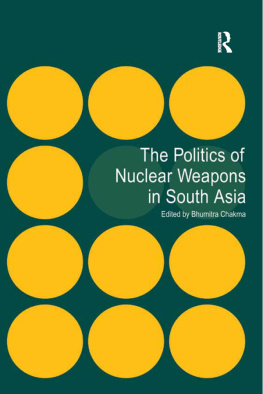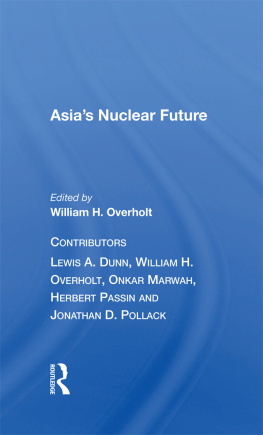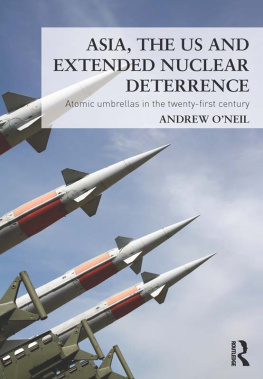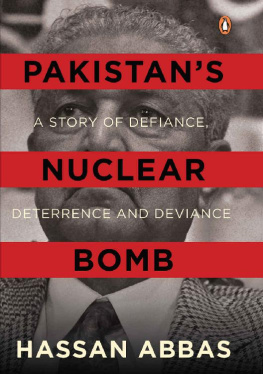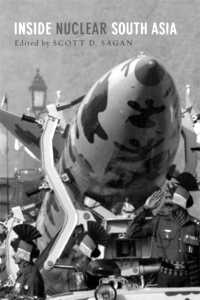South Asias Nuclear Security
South Asia is often viewed as a potential nuclear flashpoint and a probable source of nuclear terrorism. But, how valid are such perceptions? This book seeks to address this question and assesses the regions nuclear security from two principal standpoints. First, it evaluates the robustness of the IndoPakistani mutual deterrence by analysing the strength and weaknesses of the competing arguments regarding the issue. It also analyses the causes and consequences of nuclear arms race between India and Pakistan, the nature of deterrence structure in the region and the challenges of confidence building and arms control between the two countries in order to assess the robustness of South Asias nuclear deterrence. Second, it assesses the safety and security of the nuclear assets and nuclear infrastructure of India and Pakistan. The author holds that the debate on South Asias nuclear security is largely misplaced because the optimists tend to overemphasise the stabilising effects of nuclear weapons and the pessimists are too alarmists. It is argued that while the risks of nuclear weapons are significant, it is unlikely that India and Pakistan will give up their nuclear arsenals in the foreseeable future. Therefore, what needs to happen is that while nuclear elimination should be the long-term goal, in the interim years the two countries need to pursue minimum deterrence policies to reduce the likelihood of deterrence failure and the possibility of obtaining fissile materials by non-state actors.
Bhumitra Chakma is Senior Lecturer in the School of Politics, Philosophy, and International Studies and Director of the South Asia Project at Hull University. Before joining the University of Hull, he taught in International Relations Department at Dhaka University and the School of History and Politics at the University of Adelaide. He has published extensively on South Asia and the regions strategic politics. His books include: South Asia in Transition: Democracy, Political Economy and Security (Palgrave Macmillan, 2014); The Politics of Nuclear Weapons in South Asia (Ashgate, 2011); Pakistans Nuclear Weapons (Routledge, 2009); Strategic Dynamics and Nuclear Weapons Proliferation in South Asia (Peter Lang, 2004).
Routledge Security in Asia Pacific Series
Series Editors
Leszek Buszynski, Strategic and Defence Studies Centre, the Australian National University, and William Tow, Australian National University
Security issues have become more prominent in the Asia Pacific region because of the presence of global players, rising great powers, and confident middle powers, which intersect in complicated ways. This series puts forward important new work on key security issues in the region. It embraces the roles of the major actors, their defense policies and postures and their security interaction over the key issues of the region. It includes coverage of the United States, China, Japan, Russia, the Koreas, as well as the middle powers of ASEAN and South Asia. It also covers issues relating to environmental and economic security as well as transnational actors and regional groupings.
1 Bush and Asia
Americas evolving relations with East Asia
Edited by Mark Beeson
2 Japan, Australia and Asia-Pacific Security
Edited by Brad Williams and Andrew Newman
3 Regional Cooperation and Its Enemies in Northeast Asia
The impact of domestic forces
Edited by Edward Friedman and Sung Chull Kim
4 Energy Security in Asia
Edited by Michael Wesley
5 Australia as an Asia Pacific Regional Power
Friendships in flux?
Edited by Brendan Taylor
6 Securing Southeast Asia
The politics of security sector reform
Mark Beeson and Alex J. Bellamy
7 Pakistans Nuclear Weapons
Bhumitra Chakma
8 Human Security in East Asia
Challenges for collaborative action
Edited by Sorpong Peou
9 Security and International Politics in the South China Sea
Towards a co-operative management regime
Edited by Sam Bateman and Ralf Emmers
10 Japans Peace Building Diplomacy in Asia
Seeking a more active political role
Lam Peng Er
11 Geopolitics and Maritime Territorial Disputes in East Asia
Ralf Emmers
12 North Koreas MilitaryDiplomatic Campaigns, 19662008
Narushige Michishita
13 Political Change, Democratic Transitions and Security in Southeast Asia
Mely Caballero-Anthony
14 American Sanctions in the Asia-Pacific
Brendan Taylor
15 Southeast Asia and the Rise of Chinese and Indian Naval Power
Between rising naval powers
Edited by Sam Bateman and Joshua Ho
16 Human Security in Southeast Asia
Yukiko Nishikawa
17 ASEAN and the Institutionalization of East Asia
Ralf Emmers
18 India as an Asia Pacific Power
David Brewster
19 ASEAN Regionalism
Cooperation, values and institutionalisation
Christopher B. Roberts
20 Nuclear Power and Energy Security in Asia
Edited by Rajesh Basrur and Koh Swee Lean Collin
21 Maritime Challenges and Priorities in Asia
Implications for regional security
Edited by Joshua Ho and Sam Bateman
22 Human Security and Climate Change in Southeast Asia
Managing risk and resilience
Edited by Lorraine Elliott and Mely Caballero-Anthony
23 Ten Years After 9/11
Rethinking the Jihadist Threat
Arabinda Acharya
24 Bilateralism, Multilateralism and Asia-Pacific Security
Contending cooperation
Edited by William T. Tow and Brendan Taylor
25 Negotiating with North Korea
The Six Party Talks and the nuclear issue
Leszek Buszynski
26 Indias Ocean
The story of Indias bid for regional leadership
David Brewster
27 Defence Planning and Uncertainty
Preparing for the next Asia-Pacific war
Stephan Frhling
28 The South China Sea Maritime Dispute
Political, legal, and regional perspectives
Edited by Leszek Buszynski and Christopher B. Roberts
29 South Asias Nuclear Security
Bhumitra Chakma
30 The New US Strategy towards Asia
Adapting to the American pivot
Edited by William T. Tow and Douglas Stuart
First published 2015
by Routledge
2 Park Square, Milton Park, Abingdon, Oxon, OX14 4RN
and by Routledge
711 Third Avenue, New York, NY 10017
Routledge is an imprint of the Taylor & Francis Group, an informa business
2015 Bhumitra Chakma
The right of Bhumitra Chakma to be identified as author of this work has been asserted by him in accordance with the Copyright, Designs and Patent Act 1988.
All rights reserved. No part of this book may be reprinted or reproduced or utilised in any form or by any electronic, mechanical, or other means, now known or hereafter invented, including photocopying and recording, or in any information storage or retrieval system, without permission in writing from the publishers.
Trademark notice: Product or corporate names may be trademarks or registered trademarks, and are used only for identification and explanation without intent to infringe.


